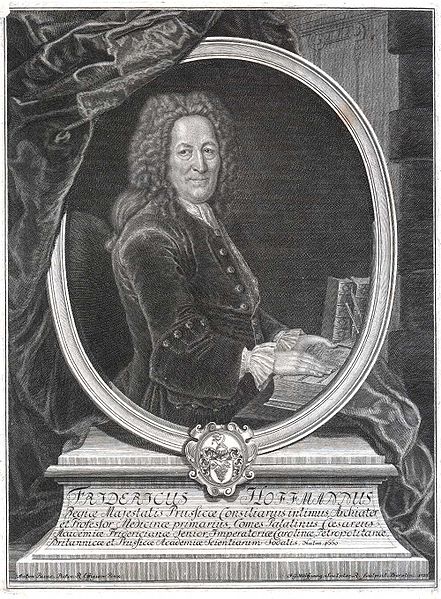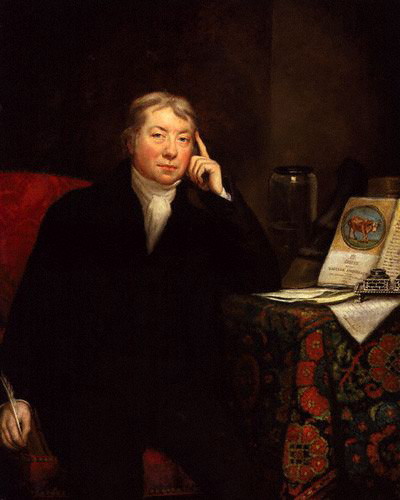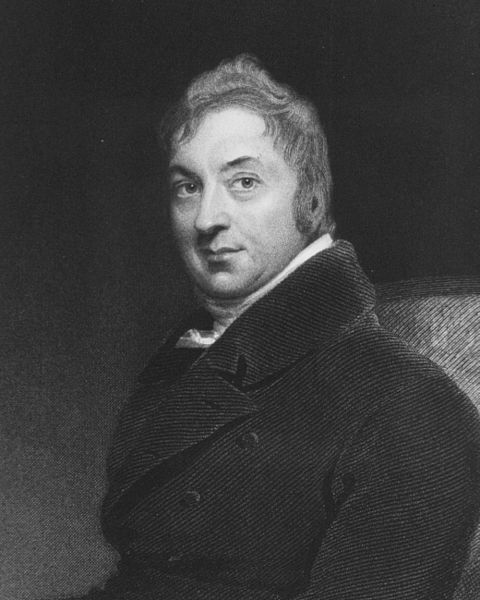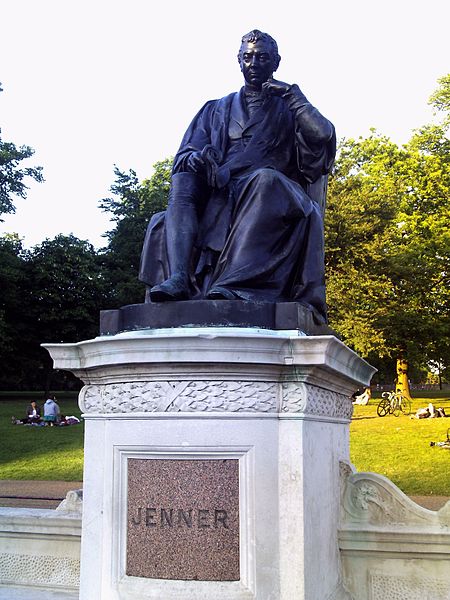<Back to Index>
- Physician and Chemist Friedrich Hoffmann, 1660
- Physician and Scientist Edward Anthony Jenner, 1749
PAGE SPONSOR

Friedrich Hoffmann (February 19, 1660 – November 12, 1742) was a German physician and chemist.
His family had been connected with medicine for 200 years before him. Born in Halle, he attended the local gymnasium where he acquired that taste for and skill in mathematics to which he attributed much of his later success. Beginning at age 18, he studied medicine at the University of Jena. From there, in 1680, he went to Erfurt, in order to attend Kasper Cramer's lectures on chemistry. Next year, returning to Jena, he received his doctor's diploma, and, after publishing a thesis, was permitted to teach. Constant study then began to tell on his health, and in 1682, leaving his already numerous pupils, he opened a practice in Minden at the request of a relative who held a high position in that town. After practicing at Minden for two years, Hoffmann made a journey to Holland and England, where he formed the acquaintance of many illustrious chemists and physicians. Towards the end of 1684, he returned to Minden, and during the next three years he received many flattering appointments. In 1688 he moved to the more promising sphere of Halberstadt, with the title of physician to the principality of Halberstadt.
In 1693, shortly after the establishment of the University of Halle, he was appointed primary professor of medicine and natural philosophy. During his career there, he held the position of rector three times. With the exception of four years (1708 – 1712), which he passed at Berlin in the capacity of royal physician, Hoffmann spent the rest of his life at Halle in instruction, practice and study, interrupted now and again by visits to different courts of Germany, where his services procured him honors and rewards. His fame became European. He was enrolled a member of many learned societies in different foreign countries (including being elected Fellow of the Royal Society in 1720), while in his own he became privy councilor.
Hoffmann died on November 12, 1742 in Halle.
Of his numerous writings a catalog is to be found in Haller's Bibliotheca medicinae practicae. The chief is Medicina rationalis systematica, undertaken at the age of sixty, and published in 1730. It was translated into French in 1739, under the title of Médecine raisonnée d'Hoffmann. A complete edition of Hoffmann's works, with a life of the author, was published at Geneva in 1740, to which supplements were added in 1753 and 1760. Editions appeared also at Venice in 1745 and at Naples in 1753 and 1793.
He wrote a witchcraft book, De Potentia Diaboli in Corpore, for his student Gottfried Büching.



Edward Anthony Jenner, FRS (17 May 1749 – 26 January 1823) was an English physician and scientist from Berkeley, Gloucestershire, who was the pioneer of smallpox vaccine. He is often called "the father of immunology", and his work is said to have "saved more lives than the work of any other man".
Edward Jenner was born on 17 May 1749 (6 May Old Style) in Berkeley, as the eighth of nine children. His father was the vicar of Berkeley, so Jenner received a strong basic education. Jenner trained from the age of 13 for eight years in Chipping Sodbury, South Gloucestershire, as an apprentice to Daniel Ludlow, a surgeon. In 1770 Jenner became apprenticed in surgery and anatomy under surgeon John Hunter and others at St George's Hospital.
William Osler records that Hunter gave Jenner William Harvey's advice, very famous in medical circles (and characteristic of the Age of Enlightenment), "Don't think; try." Hunter remained in correspondence with Jenner over natural history and proposed him for the Royal Society. Returning to his native countryside by 1773, Jenner became a successful family doctor and surgeon, practicing on dedicated premises at Berkeley.
Jenner and others formed the Fleece Medical Society or Gloucestershire Medical Society, so called because it met in the parlor of the Fleece Inn, Rodborough, in Rodborough, Gloucestershire, meeting to dine together and read papers on medical subjects. Jenner contributed papers on angina pectoris, ophthalmia and cardiac valvular disease and commented on cowpox. He also belonged to a similar society that met in Alveston, near Bristol.
Jenner was elected Fellow of the Royal Society in 1788, following his publication of a careful study of the previously misunderstood life of the nested cuckoo that combined observation, experiment and dissection.
His description of the newly hatched cuckoo, pushing its host's eggs and fledgling chicks out of the nest (contrary to existing belief that the adult cuckoo did it) was only confirmed in the 20th century, when photography became available. Having observed this behavior, Jenner demonstrated an anatomical adaptation for it — the baby cuckoo has a depression in its back, not present after twelve days of life, that enables it to cup eggs and other chicks. The adult does not remain long enough in the area to perform this task. Jenner's findings were published in Philosophical Transactions of the Royal Society in 1788.
"The singularity of its shape is well adapted to these purposes; for, different from other newly - hatched birds, its back from the scapula downwards is very broad, with a considerable depression in the middle. This depression seems formed by nature for the design of giving a more secure lodgement to the egg of the Hedge - sparrow, or its young one, when the young Cuckoo is employed in removing either of them from the nest. When it is about twelve days old, this cavity is quite filled up, and then the back assumes the shape of nestling birds in general. " (Letter to Hunter at the Royal Society, as above.)
Jenner's nephew assisted in the study.
Jenner married Catherine Kingscote (died 1815 from tuberculosis) in March 1788 after meeting her while he and other Fellows were experimenting with balloons. Jenner's trial balloon descended into Kingscote Park, Gloucestershire, owned by Anthony Kingscote, one of whose daughters was Catherine.
Jenner earned his MD from the University of St Andrews in 1792.
Jenner is also credited with advancing understanding of angina pectoris. In his correspondence with Heberden, he wrote, "How much the heart must suffer from the coronary arteries not being able to perform their functions."
Inoculation was already a standard practice but involved serious risks. In 1721 Lady Mary Wortley Montagu had imported variolation to Britain after having observed it in Istanbul, where her husband was the British ambassador. Voltaire, writing of this, estimates that at this time 60% of the population caught smallpox and 20% of the population died of it. Voltaire also states that the Circassians used the inoculation from times immemorial, and the custom may have been borrowed by the Turks from the Circassians.
In 1765, Dr John Fewster published a paper in the London Medical Society entitled "Cow pox and its ability to prevent smallpox", but he did not pursue the subject further.
In the years following 1770, at least five investigators in England and Germany (Sevel, Jensen, Jesty 1774, Rendell, Plett 1791) successfully tested a cowpox vaccine in humans against smallpox. For example, Dorset farmer Benjamin Jesty successfully vaccinated and presumably induced immunity with cowpox in his wife and two children during a smallpox epidemic in 1774, but it was not until Jenner's work some twenty years later that the procedure became widely understood. Indeed, Jenner may have been aware of Jesty's procedures and success.
Noting the common observation that milkmaids were generally immune to smallpox, Jenner postulated that the pus in the blisters that milkmaids received from cowpox (a disease similar to smallpox, but much less virulent) protected them from smallpox. He may already have heard of Benjamin Jesty's success.
On 14 May 1796, Jenner tested his hypothesis by inoculating James Phipps, a boy eight years old (the son of Jenner's gardener), with pus scraped from the cowpox blisters on the hands of Sarah Nelmes, a milkmaid who had caught cowpox from a cow called Blossom, whose hide now hangs on the wall of the St George's medical school library (now in Tooting). Phipps was the 17th case described in Jenner's first paper on vaccination.
Jenner inoculated Phipps in both arms that day, subsequently producing in Phipps a fever and some uneasiness but no full blown infection. Later, he injected Phipps with variolous material, the routine method of immunization at that time. No disease followed. The boy was later challenged with variolous material and again showed no sign of infection.
Ronald Hopkins has written, "Jenner's unique contribution was not that he inoculated a few persons with cowpox, but that he then proved [by subsequent challenges] that they were immune to smallpox. Moreover, he demonstrated that the protective cowpox pus could be effectively inoculated from person to person, not just directly from cattle. In addition Jenner successfully tested his hypothesis on 23 additional subjects.
Jenner continued his research and reported it to the Royal Society, which did not publish the initial paper. After revisions and further investigations, he published his findings on the 23 cases. Some of his conclusions were correct, some erroneous; modern microbiological and microscopic methods would make his studies easier to reproduce. The medical establishment, cautious then as now, deliberated at length over his findings before accepting them. Eventually, vaccination was accepted, and in 1840 the British government banned variolation – the use of smallpox – and provided vaccination – using cowpox – free of charge (Vaccination acts). The success of his discovery soon spread around Europe and for example was used en masse in the Spanish Balmis Expedition, a three year long mission to the Americas, Philippines, Macao, China and Saint Helena Island led by Dr. Francisco Javier de Balmis with the aim of giving thousands the smallpox vaccine. The expedition was successful, and Jenner wrote, "I don’t imagine the annals of history furnish an example of philanthropy so noble, so extensive as this."
Jenner's continuing work on vaccination prevented his continuing his ordinary medical practice. He was supported by his colleagues and the King in petitioning Parliament and was granted £10,000 for his work on vaccination. In 1806 he was granted another £20,000 for his continuing work in microbiology.
In 1803 in London he became involved with the Jennerian Institution, a society concerned with promoting vaccination to eradicate smallpox. In 1808, with government aid, this society became the National Vaccine Establishment. Jenner became a member of the Medical and Chirurgical Society on its founding in 1805 and presented a number of papers there. The society is now the Royal Society of Medicine. In 1806, Jenner was elected a foreign member of the Royal Swedish Academy of Sciences.
Returning to London in 1811, Jenner observed a significant number of cases of smallpox after vaccination. He found that in these cases the severity of the illness was notably diminished by previous vaccination. In 1821 he was appointed Physician Extraordinary to King George IV, a great national honor, and was also made Mayor of Berkeley and Justice of the Peace. He continued to investigate natural history and in 1823, the last year of his life, he presented his Observations on the Migration of Birds to the Royal Society.
Jenner was found in a state of apoplexy on 25 January 1823, with his right side paralyzed. He never fully recovered and eventually died of an apparent stroke, his second, on 26 January 1823, aged 73. He was survived by one son and one daughter, his elder son having died of tuberculosis at the age of 21.
In 1979, the World Health Organization declared smallpox an eradicated disease. This was the result of coordinated public health efforts by many people, but vaccination was an essential component. And although the disease was declared eradicated, some pus samples still remain in laboratories in Centers for Disease Control and Prevention (CDC) in Atlanta, Georgia, in the United States and State Research Center of Virology and Biotechnology VECTOR in Koltsovo, Novosibirsk Oblast, Russia.
Jenner's vaccine also laid the foundation for contemporary discoveries in immunology, and the field he began may someday lead to cures for arthritis, AIDS, and many other diseases.
An illustrated history of smallpox eradication, Smallpox Zero, was published with the support of Sanofi Pasteur and distributed on May 17, 2010, in Geneva during an event sponsored by the World Health Organization. Smallpox Zero includes President Thomas Jefferson's letter of congratulations to Edward Jenner.
In 2002, Jenner was named in the BBC's list of the 100 Greatest Britons following a UK wide vote.
- Edward Jenner is buried in the Jenner family vault at the Church of St. Mary's, Berkeley.
- Jenner's house in the village of Berkeley, Gloucestershire, is now a small museum, housing among other things the horns of the cow, Blossom.
- A statue of Jenner by Robert William Sievier was erected in the nave of Gloucester Cathedral.
- Another statue was erected in Trafalgar Square and later moved to Kensington Gardens.
- Near the Gloucestershire village of Uley, Downham Hill is locally known as "Smallpox Hill" for its possible role in Jenner's studies of the disease.
- London's St. George's Hospital Medical School has a Jenner Pavilion, where his bust may be found.
- A group of villages in Somerset County, Pennsylvania, United States, was named in Jenner's honor by early 19th century English settlers, including Jenners, Jenner Township, Jenner Crossroads, and Jennerstown, Pennsylvania.
- Jennersville, Pennsylvania, is located in Chester County.
- A section at Gloucestershire Royal Hospital is known as the Edward Jenner Ward; it is where blood is drawn
- A ward at Northwick Park Hospital is called Jenner Ward.
- Jenner Gardens at Cheltenham, Gloucestershire, opposite one of the scientist's former offices, is a small garden and cemetery.